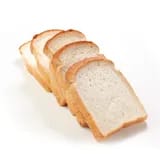Tomato Mozzarella Grilled Cheese
1266 reviewsA grilled cheese with a little touch of Mediterranean sunshine!

Ingredients
Make sure you have...
Utensil
Stovetop
recipe

Step 1
Wash & slice the tomatoes into rounds.

Step 2
Drain & slice the mozzarella into rounds.


Step 3
Spread the pesto onto both slices of bread.



Step 4
Add the tomato & mozzarella slice onto one slice of bread. Optional : if you have some, add fresh basil & pine nuts. Season with freshly grated pepper & top with arugula. Close the grilled cheese sandwich.
Step 5
Melt a dab of butter in a pan, over medium heat. Add the grilled cheese & cook for 2 min on each side, until golden brown. Cover the pan & set aside for another min.
Step 6
Slice the grilled cheese in halves or thirds & eat with a side of green salad. Enjoy !

Try making pesto from scratch ! Search "Homemade Pesto” in the app to learn how !
- Domitille, Food Editor
Personal notes
Add your own flavor!
Nutrition facts
Average estimated amount for one serving
| Energy | 753 cal. |
| Fat | 29 g |
| Carbohydrates | 90 g |
| Protein | 28 g |
| Fiber | 6 g |
Values are based on an average estimate for one serving. All nutrition information presented on Jow is intended for informational purposes only. If you have any concerns or questions about your health, please consult with a health-care professional.
On average, one serving of the recipe "Tomato Mozzarella Grilled Cheese" contains 753 Energy, 29 g of Fat, 90 g of Carbohydrates, 28 g of Protein, 6 g of Fiber.
Price per portion
| € | Nos recettes à -2 € par portion |
| €€ | Nos recettes entre 2 € et 4 € par portion |
| €€€ | Nos recettes à +4 € par portion |
Please note, the price above is dependent on your grocer and the available products in the grocery store you chose.
Scores


C Nutri-score
The Nutri-score is an indicator intended for understanding nutritional information. Recipes or products are classified from A to E according to their food composition to promote (fiber, proteins, fruits, vegetables, legumes, etc.) and foods to limit (energy, saturated fatty acids, sugars, salt, etc.).
A+ Green-score
The Green-score is an indicator representing the environmental impact of food products. The recipes or products are classified from A+ to F. It takes into account several factors on the pollution of air, water, oceans, soil, as well as the impacts on the biosphere. These impacts are studied throughout the product life cycle.
Retrieving reviews...


